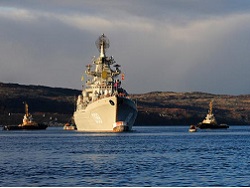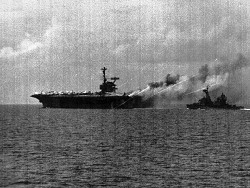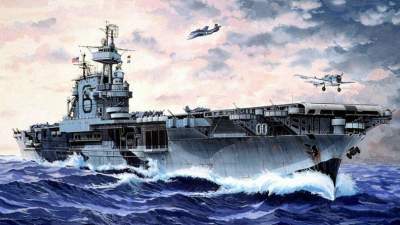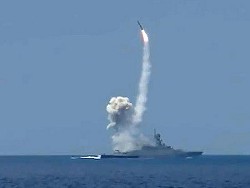
These days in Russian sector of the Arctic are the teachings of the heterogeneous forces of the fleet covering the Northern sea route, ensuring the safety of navigation and other Maritime economic activities of the Russian Federation in these latitudes. In the maneuvers involved 12 warships (including nuclear and diesel submarines, 10 support vessels, coastal missile and artillery troops and aircraft of the 45th army, air force and air defense of the Northern fleet. The geographical scale of this event — from the Kola Peninsula to the East Siberian sea.
The main participants of this exercise — a large anti-submarine ship “Vice-Admiral Kulakov”, Maritime transport weapons “Akademik Kovalev”, rescue tug boat “Pamir” and collectorname the ship KIL-164. They formed the group, which on 30 August from Severomorsk went to the archipelago of the Novosibirsk Islands. On Kotelny island, the archipelago, remember, built the largest in those parts of the Russian military base, and since 2013 modernizarea was abandoned in the Soviet years the airfield “Temp”.
In principle, almost all expected. After all, five years of Arctic Hiking surface warships and support vessels of the Northern fleet via the Northern sea route are regular. They are held annually in September-October, when ice in the water seems easier.
As one of the most important tactical episodes of the exercise is always the antilanding defense of the Islands in each of the units in the compulsory first included large amphibious ships (BDK). Only in five years, the exception that occurs in the new Siberian Islands today.
No, antilanding defense of the archipelago in 2016, is in the exercise plan. To defend the Islands these days are learning the soldiers and officers of the 200th Pechenga separate motorized rifle Arctic brigade. But, first, they first deployed there on Board specially designed for the transport of troops BDK, and on the big anti-submarine ship “Vice-Admiral Kulakov”.
Secondly, for this reason, mechanized infantry in the squad definitely quite a few free cabins and the forecastle to accommodate large landing on “Kulakov” just yet. To settle on a boat, even a dozen or two Marines, the sailors on the March should disperse completely unsuitable for living and recreation action stations “Vice-Admiral Kulakov”. On war materiel and troops, however. To put it in a ship like this is also absolutely nowhere.
But why in the current squad contrary to the current practice not a single BDK Northern fleet? Before attempting to explain this oddity, remember the timeline of the previous hikes of the Northern fleet in Arctic areas.
In 2012, the division of the 61-th separate brigade of Marines of Council of Federation from the big landing ship “Alexander Otrakovsky” for the first time in the history of the Navy landed on unequipped coast of the island Boiler.
A year later the same route on large landing ships “Kondopoga” and “St. George” the landing proceeded, accompanied by the heavy nuclear missile cruiser “Peter the Great”.
A year later, “Kondopoga” and “St. George” landed the Marines on the Boiler, with supporting fire from the large anti-submarine ship “Admiral Levchenko”.
In 2015, large anti-submarine ship “Severomorsk” and unchanged in this case “Kondopoga” and “St. George” parachuted infantry 200-th separate brigade on the Taimyr Peninsula.
There is no doubt that the detachment of the Northern fleet according to plan today’s exercises were supposed to look like this and to solve about the same problems. At least 22 of August, a large landing ship Kondopoga” along with “Vice-Admiral Kulakov” marine transport “Akademik Kovalev” and the rescue-tug ship “Pamir” have made the control output in the Barents sea. But after a week the Novosibirsk Islands, a detachment went out without the “Kondopoga”. Of the warships only “Vice-Admiral Kulakov” in it and left. That, of course, looks very frail and not at all menacing.
What happened to “Kondopoga”? We’ll never know, such information is confidential. Most likely, the problem in the sudden deterioration of the technical condition of the ship. However, no need to look in the secret papers to come to the even more unfortunate conclusion: to date no combat-ready amphibious ships in the Barents sea we have left. The already heavily worn, they are now simply driven to exhaustion in the course of the logistics operation in Syria or finish there the remainder of life. Endless flights on the route Novorossiysk-Tartus has exhausted the so-called “Syrian Express”.
To illustrate the prevailing downright tragic for the Navy of the situation the situation in the Northern fleet and will consider. Just today it includes only four BDK — “Olenegorsky Gornyak”, “Alexander Otrakovsky”, “Kondopoga” and “St. George”.
First for a long time waiting for promised repair 33-m ship-repair factory in Baltiysk. According to the press service of the plant, “will a significant amount of hull works, repair mechanisms, and upgrading of ship equipment, inspection of all mechanisms and units, including engines, piping systems, underwater and above-water parts of the hull”.
Second only in mid-summer, completed 588-daily continuous operation in the “Syrian Express”. During this time, “Alexander Otrakovsky” hosted 65 thousand nautical miles, which is about three lengths of the equator. Because of extreme deterioration of the ship to the new long March is not ready neither technically nor organizationally.
Third — “Kondopoga”. An educated guess about its fate, we already did.
Fourth — “George” — at the end of may went to the Mediterranean sea and together with the rest in the ranks of brethren from other fleets of the last forces constantly brings up the cargoes through the Straits in Tartus.
Is it normal when even our strongest fleet today is simply no one to provide paratroopers of the operating area? Even for a couple of weeks of the Novosibirsk Islands to go there? And where else, in the end, in time of peace troops to the landing carrying large anti-submarine ships?
It is clear that this is not just abnormal — catastrophic. To this situation we were decades. When in the 90s mindlessly copied and sold for scrap the BBC those who still could serve. When too long has not begun construction of new ships of this class. When the only new BDK project 11711 “Ivan Gren”, which is on the way, trying to bring to mind for the twelfth year.
Claim that “Ivan Gren”, which is from June this year is being tested in the Baltic, the Russian Navy will receive next year. And second — “Peter Morgunov” (building the Kaliningrad plant “Yantar”) service will begin in 2018. But even if everything will come true what a couple is new and not very powerful amphibious ships for four of our Navy? A further addition in this class is not visible even on the horizon.
During the prolonged discussions more or less certainly emerges of one traditional large amphibious ships of Russia to build more not going. In the future, instead we need amphibious assault ships (UDC), each of which will be much larger than the “Ivan Gren”. Accordingly, the UDC is much usedonmost desktopmetronome (naval infantry battalion) and more powerful weapons. Most importantly, the possibility to carry out the landing on remote theaters of war not only via the ramp on the sloping Bank, but with the help of helicopters and landing craft (the latter until a certain time waiting in the docking chamber UDC).
Such a ship we were going to get back in the Soviet Union. In 1981 work began on the technical design of the large landing ship-helicopter carrier of the project 11780, for the external similarity with the American type of UDC “Tarawa” immediately nicknamed “Ivan Tarawa”.
Then the Navy wished to obtain a unit with such basic tactical and technical data: displacement of about 25 thousand tons (from the above-mentioned “Ivan Gren” — 5 thousand tons), desktopmetronome — reinforced infantry battalion with the standard equipment, six landing craft of the type 1176 M or three hovercrafts type 1206, 12 transport-combat helicopter Ka-252TB or 24 anti-submarine helicopter Ka-252ПЛ (while performing anti-submarine tasks).
Oh, how we could use at least a couple of helicopter! But to put into operation “Ivan Tarawa” was going only to 1997. On the road Union collapsed, the project was put on the shelf and more it has not returned.
Now say that the first Russian UDC our Navy will receive by 2020. At least at the beginning of last summer, a milestone marked by the head of Department of shipbuilding of the Navy Vladimir rag-pickers. He added: “In the next five years will be deployed in the construction of a new generation of large amphibious ships, which at times will exceed its displacement of BDK “Ivan Gren” and BDK “Peter Morgunov”, and will have even more desktopmetronome and will be able to carry on Board one of the helicopters.”
Only all is a little hard to believe. And not only because it is far less complicated and far more modest in size “Ivan Gren” a decade and a half we build-we build and not build. Even more doubt begets another. To 2020 to landing ship, comparable in size to the heavy nuclear missile cruiser “Peter the Great”, it needs to be put in the shipyard tomorrow, right? But somehow I can’t believe this happens in the conditions of the already started very painful cuts in the state defense order. This is the time.
And two: before you begin construction, it is desirable specifically to provide: what do we expect at the output? But it seems that even in naval summit there is no such clarity.
So, Vladimir rag-pickers in a summer conversation with journalists claimed that the new Russian UDC will be “about 6 helicopters of various modifications”. And exactly a year before, in June 2015, the former Navy commander Admiral Viktor Chirkov said: “there’s new large amphibious ships, which can carry on Board up to 10 or more helicopters“.
Admirals that, looked at the different Treasury securities or is talking about different ships? Then what are we to build?
Judging by the situation in the Northern fleet, the time to seek answers to these questions are not left at all.
From the files of “SP”
You know, at least, two created in last years in Russia technical projects amphibious assault ships. In the summer of 2015, it was reported that Krylov state research center has proposed a draft UDC “Avalanche”. Its main performance characteristics are as follows:
— displacement of 24 thousand tons;
— on Board — up to 500 Marines and 50 units of military equipment;
— air group — 16 helicopters (transport and assault Ka-29 attack Ka-52K or anti-Ka-27).
Approximately at the same time similar work completed Nevskoe design Bureau. Variant promulgated under the code “Surf”. Tactical and technical characteristics “Surf”:
— displacement of about 14 thousand tons;
— on Board — up to 500 Marines and 40-60 units of military equipment;
the group — four to six helicopters.








